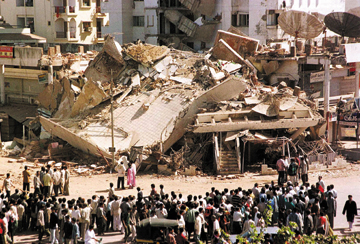This
story is expanded from the print version.


|
This
story is expanded from the print version.
|
 |
 The
year began, literally, with a magnitude-7.5 earthquake on Jan. 1 in the Philippines,
an event that occurred away from populated regions. Scientists have not yet determined
if and how this earthquake was related to another magnitude-7.5 earthquake that
occurred over 200 kilometers to the southwest on March 5 this year. The 2002 event
claimed at least 15 lives, damaged 87 buildings, and left widespread power outages
and landslides. However, a magnitude-7.7 earthquake on Jan. 13 struck close to
the shore of El Salvador, claiming at least 844 lives and 100,000 structures.
Another scant two weeks later, the most deadly earthquake of the year, the magnitude-7.6
Bhuj earthquake in western India on Jan. 26, claimed more than 20,000 lives and
more than 300,000 buildings.
The
year began, literally, with a magnitude-7.5 earthquake on Jan. 1 in the Philippines,
an event that occurred away from populated regions. Scientists have not yet determined
if and how this earthquake was related to another magnitude-7.5 earthquake that
occurred over 200 kilometers to the southwest on March 5 this year. The 2002 event
claimed at least 15 lives, damaged 87 buildings, and left widespread power outages
and landslides. However, a magnitude-7.7 earthquake on Jan. 13 struck close to
the shore of El Salvador, claiming at least 844 lives and 100,000 structures.
Another scant two weeks later, the most deadly earthquake of the year, the magnitude-7.6
Bhuj earthquake in western India on Jan. 26, claimed more than 20,000 lives and
more than 300,000 buildings.  |
Geotimes Home | AGI Home | Information Services | Geoscience Education | Public Policy | Programs | Publications | Careers |